Lesson Plan Main Idea Read Nonfiction Article
By far, 1 of the hardest skills to teach is determining the master idea of a nonfiction text. Not merely is determining chief thought pretty difficult for some (or almost depending on your class that year) students, it is also so critical for agreement nonfiction text. To make matters more complicated, and so many other nonfiction skills are also dependent on agreement that principal idea. Keeping this in mind, I choose to teach master idea iii unlike ways in an endeavor to help all of my students master this catchy skill. Keep reading to read the three approaches to didactics master idea and hopefully go some new ideas when yous teach it.
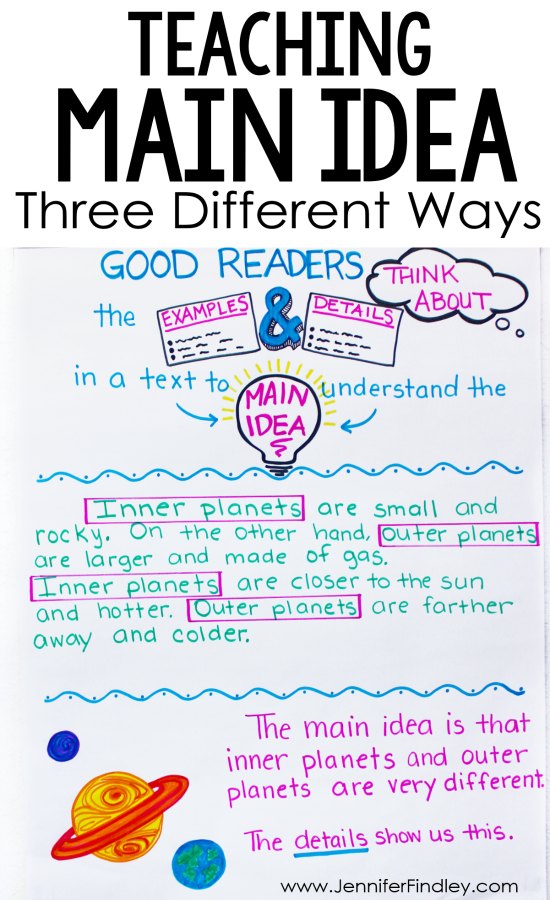
Teaching Main Idea of Nonfiction Strategies
Main Idea Strategy #1: Using Fundamental Words
Nosotros began this specific main idea strategy lesson by reading a high interest article from Zoobooks nigh Owls that was projected onto the smartboard. For the first lesson, I wanted the focus to be on key words and using those cardinal words to determine the main idea. Here is the main idea anchor chart that I used to innovate the main idea strategy:
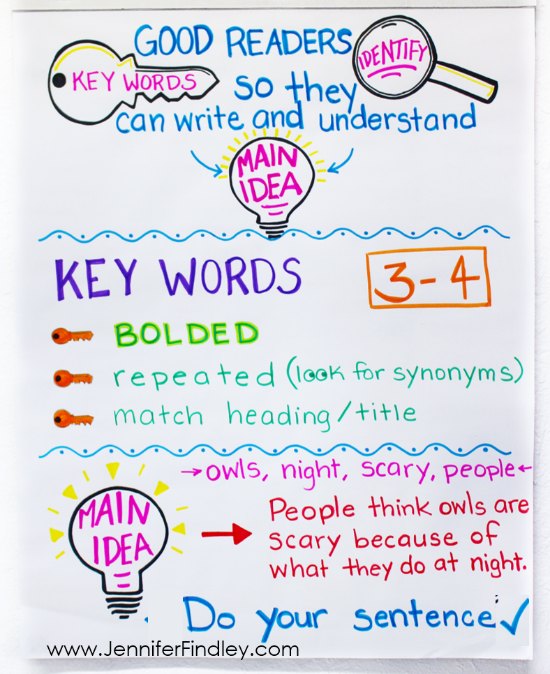 As yous can see, I taught the students that key words are either bolded, repeated (keeping in mind words that are repeated through synonyms) or they friction match the heading or the title. With the students' help, we came up with 4 key words from a paragraph in our article (specifically zoning in one paragraph at a time is key to scaffolding understanding). We supported the choice of key words by discussing which requirement they met to be chosen a key word. Then we turned our key words into a main thought sentence.
As yous can see, I taught the students that key words are either bolded, repeated (keeping in mind words that are repeated through synonyms) or they friction match the heading or the title. With the students' help, we came up with 4 key words from a paragraph in our article (specifically zoning in one paragraph at a time is key to scaffolding understanding). We supported the choice of key words by discussing which requirement they met to be chosen a key word. Then we turned our key words into a main thought sentence.
Finally we completed what I call a "Judgement Check." This is where we cheque each sentence (or randomly select a few) and make sure they friction match the main idea. If each sentence is not connected to the master idea in some way, our main idea sentence may not be authentic or complete. This actually helps them not choose main idea sentences that are just interesting details.
Main Thought Strategy #ii: What To Do When You Take Choices
The side by side strategy we talked most after ii days of practice with the key word strategy shared above was how to decide the principal idea when you take choices. I had this main thought ballast chart prepped earlier the lesson with four possible chief ideas for a specific paragraph in the aforementioned owl article. We read that particular section of the same owl article and thought carefully virtually what the author was trying to tell us.
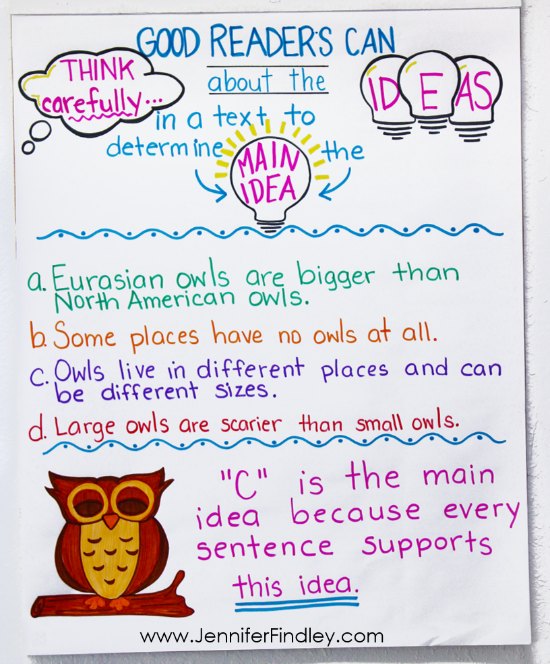
After reading the department and discussing with our partners what we thought the author was trying to tell us with the information, nosotros looked at our choices. We read each choice and went back to the section to determine if it was the main idea. We used our "Sentence Check" from the previous lesson to justify our answers. It was really dandy hearing the students say things like, "That is simply a detail and the other sentences don't actually talk virtually that." Or "That sentence is an opinion and doesn't match the details in the paragraph." We chose our reply based on the fact that all of our sentences supported that thought.
Main Idea Strategy #3: What are the details or examples showing y'all?
For this mini lesson, we moved away from our commodity and used a nonfiction mentor text on sharks. I chose this book considering it contained peachy examples through the text and the illustrations. For this lesson I wanted to explore text that didn't really have key words, but instead used details and examples to illustrate the main idea. Click hither to encounter my other recommended mentor texts and read alouds for teaching main thought.

Before reading the shark mentor text, we looked at a quick example that I had written on nautical chart paper. We read information technology aloud and discussed with a partner what the author was trying to show united states through the details provided. Since this was a familiar topic, nigh of them were really quick to detect that the details were showing that the inner planets are different from the outer planets.
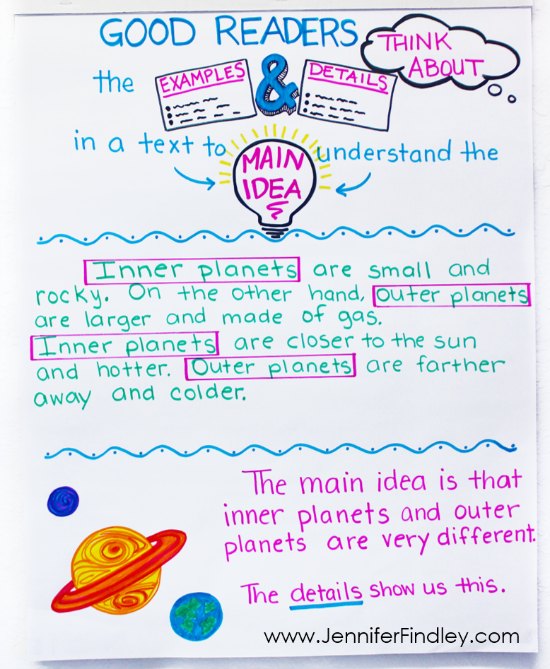
Later reading the brusque paragraph, we discussed how the main thought was not stated or even shown through primal words. Instead, the reader used the examples and the details to show the reader the primary idea.
After discussing this and doing another plough and talk discussion with our partners, we read a few pages from the mentor text mentioned above. We did several main idea sentences together using the book and then I chose a page for them to consummate on their own. They were given a post information technology note where they had to determine the main idea. Information technology was really interesting because some of them allow the examples guide them and some of them fifty-fifty chose to use cardinal words to help them from our previous lessons. They posted their responses on our chart.
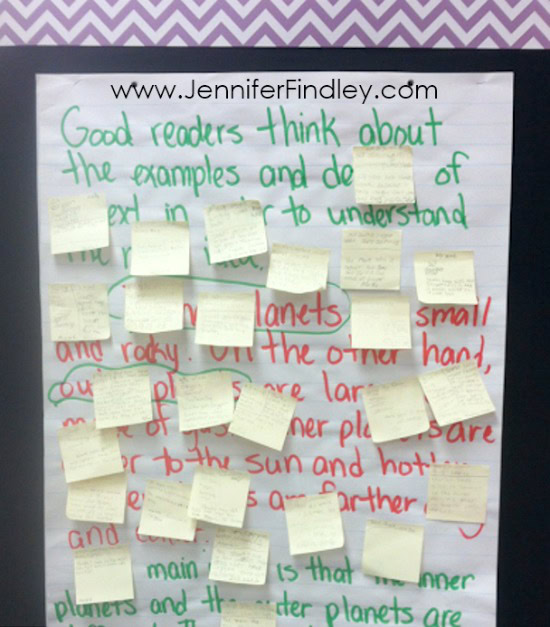 Adjacent week, we move on to summarizing nonfiction text. I promise to be able to refer to these lessons to guide that instruction besides. While I am pedagogy summarizing, I volition have the students use these main idea strategies to passages during their reading centers. I use longer passages from my Teaching Chief Idea unit of measurement. These passages are perfect considering each paragraph has a specific master idea.
Adjacent week, we move on to summarizing nonfiction text. I promise to be able to refer to these lessons to guide that instruction besides. While I am pedagogy summarizing, I volition have the students use these main idea strategies to passages during their reading centers. I use longer passages from my Teaching Chief Idea unit of measurement. These passages are perfect considering each paragraph has a specific master idea.
Do yous have any tips or strategies for didactics chief idea of nonfiction text? I am always looking for more strategies to share with my students.
Save
Source: https://jenniferfindley.com/teaching-main-idea-of-nonfiction-text-3/
0 Response to "Lesson Plan Main Idea Read Nonfiction Article"
Post a Comment